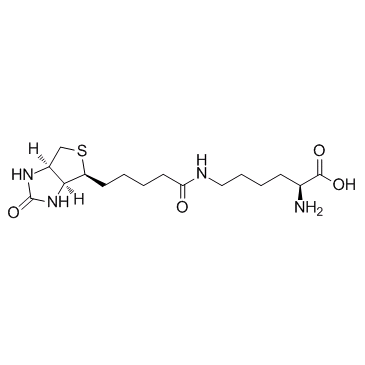Biocytin

Biocytin structure
|
Common Name | Biocytin | ||
|---|---|---|---|---|
| CAS Number | 576-19-2 | Molecular Weight | 372.483 | |
| Density | 1.2±0.1 g/cm3 | Boiling Point | 748.0±60.0 °C at 760 mmHg | |
| Molecular Formula | C16H28N4O4S | Melting Point | -245ºC (dec.) | |
| MSDS | Chinese USA | Flash Point | 406.2±32.9 °C | |
|
Frequency-dependent, cell type-divergent signaling in the hippocamposeptal projection.
J. Neurosci. 34(35) , 11769-80, (2014) Hippocampal oscillations are critical for information processing, and are strongly influenced by inputs from the medial septum. Hippocamposeptal neurons provide direct inhibitory feedback from the hippocampus onto septal cells, and are therefore likely to als... |
|
|
LRRK2 overexpression alters glutamatergic presynaptic plasticity, striatal dopamine tone, postsynaptic signal transduction, motor activity and memory.
Hum. Mol. Genet. 24(5) , 1336-49, (2015) Mutations in leucine-rich repeat kinase 2 (Lrrk2) are the most common genetic cause of Parkinson's disease (PD), a neurodegenerative disorder affecting 1-2% of those >65 years old. The neurophysiology of LRRK2 remains largely elusive, although protein loss su... |
|
|
TRPV4 regulates the integrity of the blood-cerebrospinal fluid barrier and modulates transepithelial protein transport.
FASEB J. 29 , 2247-59, (2015) The diffusion of materials from systemic circulation to the central nervous system (CNS) is restricted by the blood-brain barrier (BBB) and the blood-cerebrospinal fluid barrier (BCSFB). Choroid plexus epithelial cells (CPECs) of the brain ventricles constitu... |
|
|
Decreasing Transmembrane Segment Length Greatly Decreases Perfringolysin O Pore Size.
J. Membr. Biol. 248 , 517-27, (2015) Perfringolysin O (PFO) is a transmembrane (TM) β-barrel protein that inserts into mammalian cell membranes. Once inserted into membranes, PFO assembles into pore-forming oligomers containing 30-50 PFO monomers. These form a pore of up to 300 Å, far exceeding ... |
|
|
A generic approach to engineer antibody pH-switches using combinatorial histidine scanning libraries and yeast display.
MAbs 7(1) , 138-51, (2015) There is growing interest in the fast and robust engineering of protein pH-sensitivity that aims to reduce binding at acidic pH, compared to neutral pH. Here, we describe a novel strategy for the incorporation of pH-sensitive antigen binding functions into an... |
|
|
Identification of lysine residues in the Borrelia burgdorferi DbpA adhesin required for murine infection.
Infect. Immun. 82(8) , 3186-98, (2014) Decorin-binding protein A (DbpA) of Borrelia burgdorferi mediates bacterial adhesion to heparin and dermatan sulfate associated with decorin. Lysines K82, K163, and K170 of DbpA are known to be important for in vitro interaction with decorin, and the DbpA str... |
|
|
Protracted brain development in a rodent model of extreme longevity.
Sci. Rep. 5 , 11592, (2015) Extreme longevity requires the continuous and large-scale adaptation of organ systems to delay senescence. Naked mole rats are the longest-living rodents, whose nervous system likely undergoes life-long adaptive reorganization. Nevertheless, neither the cellu... |
|
|
Phasic, nonsynaptic GABA-A receptor-mediated inhibition entrains thalamocortical oscillations.
J. Neurosci. 34(21) , 7137-47, (2014) GABA-A receptors (GABA-ARs) are typically expressed at synaptic or nonsynaptic sites mediating phasic and tonic inhibition, respectively. These two forms of inhibition conjointly control various network oscillations. To disentangle their roles in thalamocorti... |
|
|
Excitatory Postrhinal Projections to Principal Cells in the Medial Entorhinal Cortex.
J. Neurosci. 35 , 15860-74, (2015) The postrhinal cortex (POR) provides substantial input to the entorhinal cortex, mainly targeting superficial layers of the medial entorhinal cortex (MEC). Major inputs to POR originate in the visual and parietal cortex, thus providing neurons in MEC with a s... |
|
|
Multiple Forms of Endocannabinoid and Endovanilloid Signaling Regulate the Tonic Control of GABA Release.
J. Neurosci. 35 , 10039-57, (2015) Persistent CB1 cannabinoid receptor activity limits neurotransmitter release at various synapses throughout the brain. However, it is not fully understood how constitutively active CB1 receptors, tonic endocannabinoid signaling, and its regulation by multiple... |